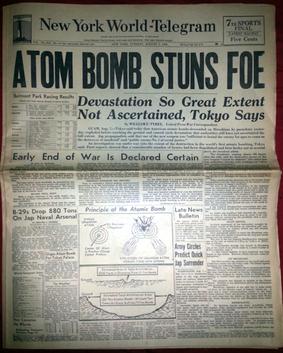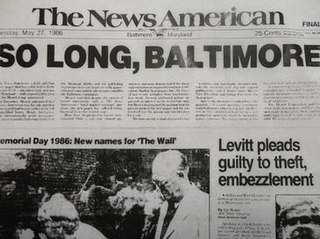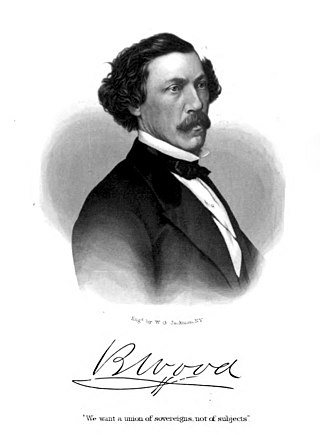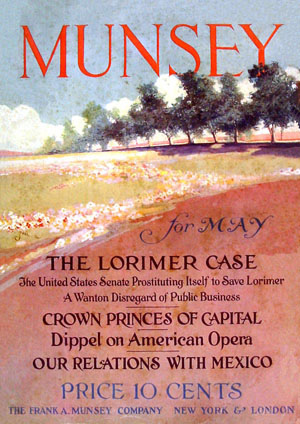
The New York World-Telegram, later known as the New York World-Telegram and The Sun, was a New York City newspaper from 1931 to 1966.

The New York Herald was a large-distribution newspaper based in New York City that existed between 1835 and 1924. At that point it was acquired by its smaller rival the New-York Tribune to form the New York Herald Tribune.

The Richmond Times-Dispatch is the primary daily newspaper in Richmond, Virginia, and the primary newspaper of record for the state of Virginia.

The Sun was a New York newspaper published from 1833 until 1950. It was considered a serious paper, like the city's two more successful broadsheets, The New York Times and the New York Herald Tribune. The Sun was the first successful penny daily newspaper in the United States, and was for a time, the most successful newspaper in America.
The Birmingham Post is a weekly printed newspaper based in Birmingham, England, with distribution throughout the West Midlands. First published under the name the Birmingham Daily Post in 1857, it has had a succession of distinguished editors and has played an influential role in the life and politics of the city. It is currently owned by Reach plc. In June 2013, it launched a daily tablet edition called Birmingham Post Business Daily.

The Argus was an Australian daily morning newspaper in Melbourne from 2 June 1846 to 19 January 1957, and was considered to be the general Australian newspaper of record for this period. Widely known as a conservative newspaper for most of its history, it adopted a left-leaning approach from 1949. The Argus's main competitor was David Syme's more liberal-minded newspaper, The Age.

The Baltimore News-American was a broadsheet newspaper published in downtown Baltimore, Maryland until May 27, 1986. It had a continuous lineage of more than 200 years. For much of the mid-20th century, it had the largest circulation in the city.

The Wisconsin State Journal is a daily newspaper published in Madison, Wisconsin by Lee Enterprises. The newspaper, the second largest in Wisconsin, is primarily distributed in a 19 county region in south-central Wisconsin. As of September 2018, the Wisconsin State Journal had an average weekday circulation of 51,303 and an average Sunday circulation of 64,820. The State Journal is the state's official newspaper of record, and statutes and laws passed are regarded as official seven days after the publication of a state legal notice.

The Statesman Journal is the major daily newspaper published in Salem, Oregon, United States. Founded in 1851 as the Oregon Statesman, it later merged with the Capital Journal to form the current newspaper, the second-oldest in Oregon. The Statesman Journal is distributed in Salem, Keizer, and portions of the mid-Willamette Valley. The average weekday circulation was 27,859, with Sunday's readership listed at 36,323, in 2012.. It is owned, along with the neighboring Stayton Mail and Silverton Appeal Tribune, by the national Gannett Company.

Frank Andrew Munsey was an American newspaper and magazine publisher, banker, political financier and author. He was born in Mercer, Maine, but spent most of his life in New York City. The village of Munsey Park, New York, is named for him, along with The Munsey Building in downtown Baltimore, Maryland, at the southeast corner of North Calvert and East Fayette Streets.

Benjamin Wood was an American politician and publishing entrepreneur from the state of New York during the American Civil War.

Stilson Hutchins was an American newspaper reporter and publisher, best known as founder of the broadsheet newspaper The Washington Post. Hutchins was also a Southern sympathizer and an outspoken racist against African Americans, Asian Americans, and immigrants.

The Sun Journal is a newspaper published in Lewiston, Maine, United States, which covers central and western Maine. In addition to its main office in Lewiston, the newspaper also maintains satellite news and sales bureaus in the Maine towns of Farmington, Norway and Rumford. It is the third largest daily newspaper by circulation in Maine.

The Public Ledger was a daily newspaper in Philadelphia, Pennsylvania, published from March 25, 1836, to January 1942. Its motto was "Virtue, Liberty, and Independence". It was Philadelphia's most widely-circulated newspaper for a period, but its circulation began declining in the mid-1930s. The newspaper also operated a syndicate, the Ledger Syndicate, from 1915 until 1946.

The Idaho Press of Nampa, Idaho is the second-oldest active newspaper in Idaho, first printed in December 1883. In its early years, the newspaper was often an instrument of political influence. One of the first owners and editors was Frank Steunenberg.

Munsey's Magazine was an American magazine founded by Frank Munsey. Originally launched in 1889 as Munsey's Weekly, a humorous magazine, edited by John Kendrick Bangs, it was not successful, and by late 1891 had lost $100,000. Munsey converted it to a general illustrated monthly in October of that year, retitled Munsey's Magazine and priced at twenty-five cents. Richard Titherington became the editor, and remained in that role for the rest of the magazine's existence. In 1893 Munsey reduced the price to ten cents : this brought him into conflict with the American News Company, which had a near-monopoly on magazine distribution, as they were unwilling to handle the magazine at the cost Munsey asked for. Munsey started his own distribution company and was quickly successful: the first issue at ten cents began with a print run of 20,000 copies but eventually sold 60,000, and within a year circulation had risen to over a quarter of a million issues.

The Chicago Daily Journal was a Chicago newspaper that published from 1844 to 1929.

Lloyd's Weekly Newspaper, called the Sunday News after 1924, was an early Sunday newspaper in the United Kingdom, launched in 1842., ceased publication in 1931.
The Sunday Mercury (1839–1896) was a weekly Sunday newspaper published in New York City that grew to become the highest-circulation weekly newspaper in the United States at its peak. It was known for publishing and popularizing the work of many notable 19th-century writers, including Charles Farrar Browne and Robert Henry Newell, and was the first Eastern paper to publish Mark Twain. It was also the first newspaper to provide regular coverage of baseball, and was popular for the extensive war correspondence from soldiers it published during the Civil War.
The Otago Witness was a prominent illustrated weekly newspaper in the early years of the European settlement of New Zealand, produced in Dunedin, the provincial capital of Otago. Published weekly, it existed from 1851 to 1932. The introduction of the Otago Daily Times, followed by other daily newspapers in its circulation area, led it to focus on serving a rural readership in the lower South Island, where poor road access prevented newspapers being delivered daily. It also provided an outlet for local fiction writers. It is notable as the first newspaper to use illustrations and photographs and was the first New Zealand newspaper to provide a correspondence column for children, which was known as "Dot's Little Folk". Together with the Auckland-based Weekly News and the Wellington-based New Zealand Free Lance it was one of the most significant illustrated weekly New Zealand newspapers in the 19th and early 20th centuries.

















